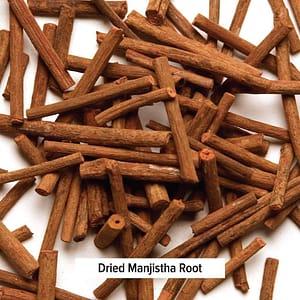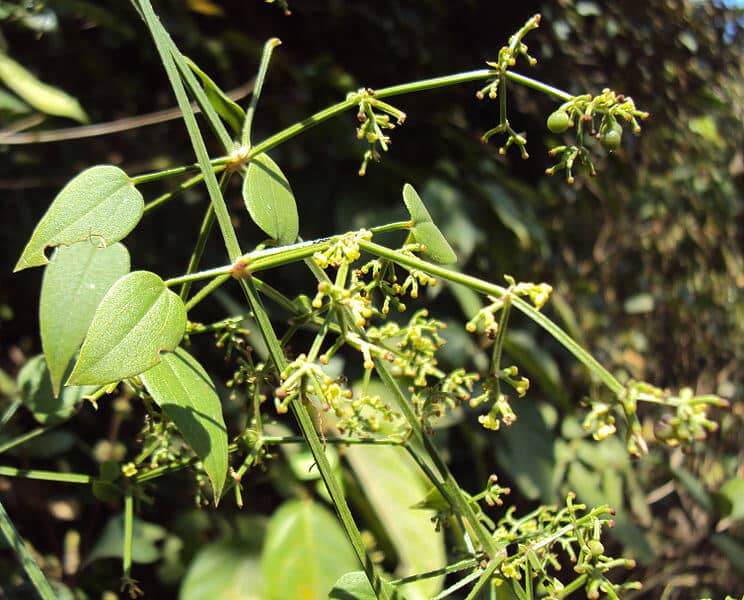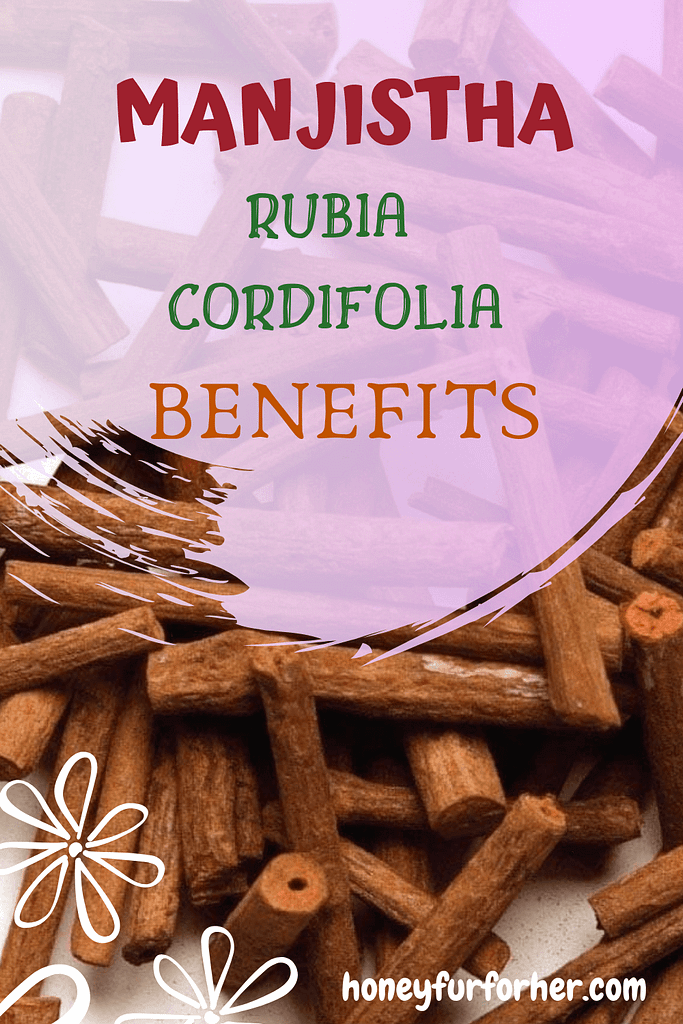
Ever heard of an Ayurvedic herb that’s so famous and effective that it has been mentioned in all the three texts of Ayurveda: Charaka Samhita, Sushruta Samhita and Ashtanga Hridaya? The herb we will be discussing today is called Manjistha – also known as rakta shodhak or blood purifier.
It has other names and forms: Whether you call it Rubia Cordifolia (Botanical name), Manjeeth (Hindi name), Indian Madder (English name), or Manjistha (Sanskrit name), this power-player perennial herb in Ayurvedic circles is well-known and deservedly respected. It belongs to the coffee family of plants and is grown along the foot of the Himalayas. Best of all can be consumed in diverse forms: capsules, oil, or a decoction.
Also dubbed as the “lymph mover” and blood purifier, Manjistha comes with manifold health and wellness benefits.
Fun Facts Centred around Manjistha:
- An Australian clothing label, “Kitx” uses Ayurvedic recipes to dye fabrics, infusing garments with anti-bacterial properties! Dubbing it as “conscious, healing” fashion, Manjistha has been used in the collection to create a passionate red colour that’s beautiful and comes with healing properties!
- Channapatna toy-makers also make use of Manjistha to create toys laced with child-safe lacquer as it is natural and non-toxic in nature.
- The Council of Scientific & Industrial Research has launched a scientifically-validated Ayurvedic drug – BGR-34 – to treat type II diabetes. This drug comprises 6 ayurvedic herbs namely, daruharidra, giloy, vijayasar, gudmar, manjistha, and methika.
Manjistha’s Multi-Purpose Uses: An Overview

Manjistha can be used internally and externally. Researchers from the Florida International University claim that extracts from Rubia Cordifolia when teamed up with traditional anti-retroviral drugs can possibly treat HIV! Presumably, because it comes with potent immunity-boosting properties. This is just scratching the surface when it comes to understanding the multi-dimensional benefits and Rubia Cordifolia’s holistic uses.
It wouldn’t be an exaggeration to tag the Manjistha plant as a prized possession. It comes with heart-shaped leaves and its stem is the most commonly used part of the plant which is known to work wonderfully on the arterial and circulatory systems in the body. Manistha’s bright red stems and roots lend themselves useful as a gorgeous, natural dye for clothes imparting colours of red, scarlet, brown, and mauve. This makes sense as literally translated, the Manjistha means “bright red.”
Looking at Manjistha powder’s uses, it is known to calm an aggravated pitta and break up a congested kapha.
How To Make The Manjistha Tea (Kwath) Yourself?
Ingredients
- 200 ml of water
- 1/4 tsp Manjistha churna
- Honey
Steps To Follow
- Boil the water in a pot.
- Mix 1/4 teaspoon of Manjistha powder and stir well. Allow the herb to steep in the water.
- Strain and add honey (as per taste). Voila, you’re done!
Note: This hot infusion is beneficial during the post-natal period and helps in cleansing the uterus.
How to make the Manjisthadi Kwath?
Prepare a powder by grinding the following herbs in equal parts: Manjistha, Amalaki, haritaki, bibhitaki, kutki, the bark of neem, the bark of pippali, Guduchi and Chandan. Take 1 teaspoon of this powder, boil it in a cup of water until one-fourth part of water remains, strain and consume.
Note: This decoction helps in case of gouty arthritis and treats a variety of skin diseases.
Recommended Dosage:
- 2 teaspoons or 20-50 ml (in divided doses) of Manjistha decoction (added to your kadha) once a day.
- 1-2 capsules twice daily if you prefer going for the oral route.
- 1-3 gms for the Manjistha powder.
Important: Please consult your doctor before consuming it in any form just as a precautionary measure. It’s important to understand the recommended dosage based on your body type and medical history.
Manjistha’s Medicinal Properties
- Anti-bacterial
- Anti-microbial
- Anti-inflammatory
- Analgesic
- Anti-diarrhoeal
- Diuretic
A Glimpse of its Physical Properties
- Taste: Bitter, sweet, astringent.
- Energy: Cooling
- Post-digestive effect: Pungent
- Quality: Heavy, dry.
Manjistha’s Bevy of Health Benefits

Manjistha powder’s benefits are aplenty and comprehensive. For one, it acts as a muscle relaxant and can ease stress, anxiety and depression. Two, it can heal diabetic ulcers. Three, it is known to destroy malignant and benign cancer tumours. Let’s look at some of its other benefits in greater detail.
Manjistha For Skin
Manjistha is the perfect natural herb for the largest detoxifying organ of the body – the skin. Whether it’s used for skin whitening and lightening scars/marks, or for treating various skin issues such as speedy-healing of wounds and taking care of skin allergies, this herb is a God-send. When applied topically, it combats dry skin, rashes, itchiness, and inflammation. All in all, it caters to all kinds of problems on the skin spectrum.
Suggested Remedy:
Manjistha powder can be used in combination with milk, pure honey, and sandalwood powder to make a DIY face pack and scrub. Alternatively, you can mix honey or yoghurt with powdered manjistha and apply it to the face or body as a mask for 10-15 minutes. Plus, when used in equal parts with another herb called Harida, it takes care of acute skin diseases. For rashes, you can mix manjistha powder with neem powder and coconut oil and apply on the affected areas.
Manjistha Oil For Skin
Massaging with this oil helps with acne, clears the face, evens the skin tone, and irons out wrinkles. Ayurvedic texts recommended massaging your skin with this oil for seven consecutive nights to make your face glow. Manjistha is the primary ingredient in super-powerful oils such as Mahanarayan oil and Pinda Thailam (made from honeybee wax, Rubia Cordifolia, the resin of Vateria indica, Hemidesmus indicus and Sesame oil). Both oils are extremely useful for alleviating muscle pain, treating arthritis, and swelling, curing cracked heels, etc.
The Suggested Remedy For Cracked Heels:
Massage your feet soles with equal parts of slightly warm Dhanwantaram thailam and Pinda thailam. After 15 minutes, soak the feet in warm water. For immediate relief, add lime juice or fermented rice water to the warm water and see the pain vanish! Conversely, you can create your own lotion for cracked heels by combining 8 grams of manjistha powder, 1 egg, 1 teaspoon of honey, 1 teaspoon of aloe vera gel, and 30gm almond powder. All you need to do is beat the egg and mix all the ingredients together.
Manjistha For The Lymphatic System
Manjistha aids in the smooth functioning of the lymph – which is the core of the immune system and is primarily responsible for getting rid of toxic buildup in the body.
Suggested Remedy For Breast Massage
Here’s the recipe for a DIY breast balm: Wellness experts suggest that women massage their breasts at least once a week as massaging it stimulates the lymph flow and aids in a smooth-running detox mechanism. To create your own breast balm, mix 1/2 cup sunflower oil and 1/2 cup coconut oil in a clear bottle. Add 20 drops of Frankincense in the bottle. Next, add some liquorice root, Punarnava root and Manjistha root. Close the lid and shake. That’s it, you’re done! Massage with this balm in circular motions every night or as often as possible.
Blood Purifier
One of its biggest benefits is that it can flush out various toxins in the body.
Suggested Remedy
It is supplemented with Neem, Turmeric, Guduchi, and burdock to form an effective decoction that purifies the blood.
Tuberculosis
Researchers at the University of Limpopo claim that Manjistha’s leaf extracts exhibit anti-inflammatory properties and can resist the growth of the virus effectively. In sum, it can help treat TB and protect one’s lungs.
Insect Bites / Stings
Manjistha is used to treat insect stings. Interestingly, Manjistha’s flower closes when an insect sits on it. Hence, it is aptly coined “insect-eater.”
Digestion
It kindles the digestive fire, treats constipation, and helps get rid of worms – all these factors aid in strengthening the digestive system.
Irregular Periods / PCOD
Manjistha helps in regulating periods, treating postnatal ailments, and helps treat excessive abdominal pain/bleeding. Plus, it relieves pain during dysmenorrhea and encourages easy flow during the menstrual cycle. For women suffering from PCOD, combine Aloe Vera pulp with Manjistha capsules. It helps in purifying the blood and restores uterus health leading to regular, healthy periods. For women suffering from a foul menstrual blood smell, they can take Manjistha capsules.
UTI
Manjistha helps in treating Urinary Tract Infections due to its diuretic and anti-microbial properties.
Regulating Blood Sugar And Blood Pressure Levels
Putting a cap on blood sugar levels, Manjistha also helps in regulating blood pressure levels in the body. It also aids in narrowing of blood vessels, heart blockage, as well as blood clot formation.
Calcium Deficiency
A decoction of manjistha is helpful in treating rickets and calcium deficiency.
Gall Bladder Stones
Manjistha cleans and regulates the pancreas, spleen, liver and kidneys which, in turn, help in cleansing the body.
Manjistha’s Side-Effects & Precautionary Measures
- Pregnant and lactating mothers should avoid it.
- Consuming it can change the colour of your urine and stool to orange/brown.
Important: Please consult your doctor before consuming this herb as a precautionary measure.
Did you find this post useful? Would you like to get back to it later? Save THIS PIN below to your Pinterest Natural Living or Ayurveda board!


Very good information.